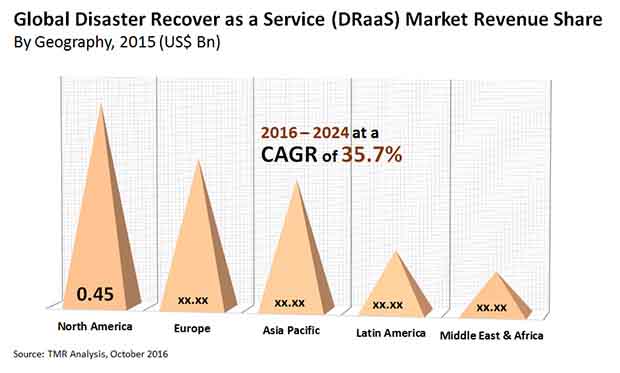
The market for traditional disaster recovery systems (DR) has witnessed vast changes over the past decade. The advent and rising adoption of cloud-based disaster recovery services (also formally referred to disaster recovery as-a-service or DRaaS) has transformed the market and has significantly resulted in the replacement of traditional DR systems with the former. The drastic change in the growth dynamics of the traditional DR market has compelled many leading players in this field to make the move to cloud-based DR systems and services. This has introduced a large number of companies in the market, significantly intensifying competition as well as providing consumers a vast number of options to choose from.
The market is expected to exhibit a remarkable 35.7% CAGR over the period between 2016 and 2024, states Transparency Market Research. If the prediction holds true, the market, which had a valuation of US$1.29 bn in 2015, is expected to rise to US$21.55 bn by 2024, in terms of revenue.

Government, IT and Telecom Sectors to Continue to be Most Lucrative
On the basis of key applications of DRaaS, the global DRaaS market has been segmented into banking, financial services and insurance (BFSI), government, IT and telecom, media and entertainment, manufacturing and logistics, and education. Of these, the government sector contributed the dominant share of 18.3% of the overall market in 2015. The vast demand for DRaaS solutions and services in the sector is attributed to the increased level of digitization across a number of processes and operations and the resultant rise in need for backing up critical public and private data.
The global DRaaS market also earns a sizeable share in its revenues owing to applications across the IT and telecom sector, which is currently witnessing expansion at a high pace owing to the high number of startups and new online-based services entering the online retail market. Most IT and telecom companies have their data/business operations in the cloud and require an efficient disaster recovery plan to ensure smooth continuity of business.
Ask for brochure:
https://www.transparencymarketresearch.com/sample/sample.php?flag=B&rep_id=3622
Rising Number of SMEs in Asia Pacific Region to Grant Vast Scope for Market Expansion
Globally, North America dominated the global DRaaS market in terms of revenue, accounting for more than 34.0% in 2015 and is expected to continue dominance over the forecast period as well. The key force impelling the DRaaS market in North America is the presence of a large number of SMEs seeking affordable DRaaS solution and services. In the U.S., government departments and the public sector are also deploying DRaaS services to gain cost benefits. The presence of a large number of vendors and the resultant rise in the number of cost competitive options, for enterprises to choose from, has also helped bolster the growth prospects of the North America market.
Asia Pacific is expected to be the regional market with the most promising growth rate over the forecast period. Customized DRaaS solutions offered by multiple vendors/service providers are key to the excellent growth prospects of the DRaaS market in the region. An increasing number of companies in the region are experimenting with cloud-based disaster recovery solutions as technology service providers are developing new offerings designed to fit the specifications and budgets of customers.
Government initiatives and policies to promote business-friendly environment are encouraging multinational firms to invest in the region. This is likely to boost demand for DRaaS solutions. E-commerce companies in the region are expanding significantly. This, coupled with strong recovery of the telecommunication segment and growth in the manufacturing and the government segments, is estimated to continue to drive the Asia Pacific DRaaS market over the forecast period.
Some of the key players operating in the global DRaaS market are IBM Corp., VMWare, Inc., Cisco Systems, Inc., Symantec Corporation, Amazon Web Services, and Commvault.
Read Our Latest Press Release:





